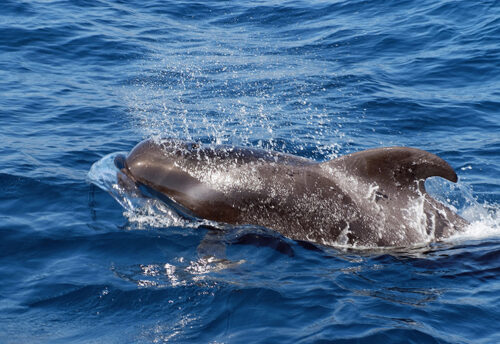
The humpback dolphin dwells among the shallow shoreline waters along the coastlines of Africa, Asia, and Australia. There are 4 recognized subspecies: the Indo-Pacific humpback, Indian Ocean humpback, Atlantic humpback, and the Australian humpback dolphin. Unfortunately, these dolphins face the threats of habitat destruction at the hands of residential and commercial developments, oil and gas drilling, mining, quarrying, and renewable energy; boat strike (being hit by aquatic vessels) due to swimming in shipping lanes; overfishing; human intrusion; bycatch (being caught in fishing lines and nets), and ecosystem modifications. The IUCN lists these dolphins anywhere from Vulnerable to Critically Endangered. Their numbers are also decreasing.
First the Stats…
Scientific name: Sousa sahulensis, chinensis, plumbea, and teuszii
Weight: Up to 440 lbs.
Length: Up to 9.2 feet
Lifespan: Up to 40 years
Now on to the Facts!
1.) These dolphins are usually more shy and less active than bottlenose species.
2.) They get their name due to the distinctive hump in front of their dorsal fin and also a keel on their stomach.
3.) Humpbacks are typically a slower-moving, shallower diving delphinid species when compared to the bottlenose dolphin.
4.) A majority of research involving these dolphins has taken place among the South African populations in Algoa Bay and Richards Bay. So this may not accurately reflect all 4 subspecies.
5.) Fish, octopus, and squid make up their diet.
But wait, there’s more on the humpback dolphin!
6.) They have been documented partially beaching themselves to chase after various fish.
7.) As a testament to learned behavior, they have also been seen trailing fish trawlers to catch discarded or escaped fish from nets.
Did you know…?
The average speed of these dolphins is up to 3 mph, with the potential for faster bursts.
8.) Females undergo up to a 12 month gestation (pregnancy) that yields a single calf.
9.) Calves are weaned in up to 2 years.
10.) Great white sharks, tiger sharks, bull sharks, and orcas are all known to prey on either the calves or adults.
Now a Short Humpback Dolphin Video!
Be sure to share & comment below! Also, check out the Critter Science YouTube channel. Videos added regularly!
Want to suggest a critter for me to write about? Let me know here.
Some source material acquired from: Wikipedia & IUCN
Photo credit: G. J. Parra



